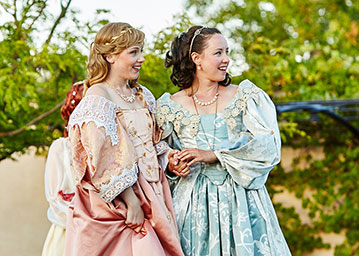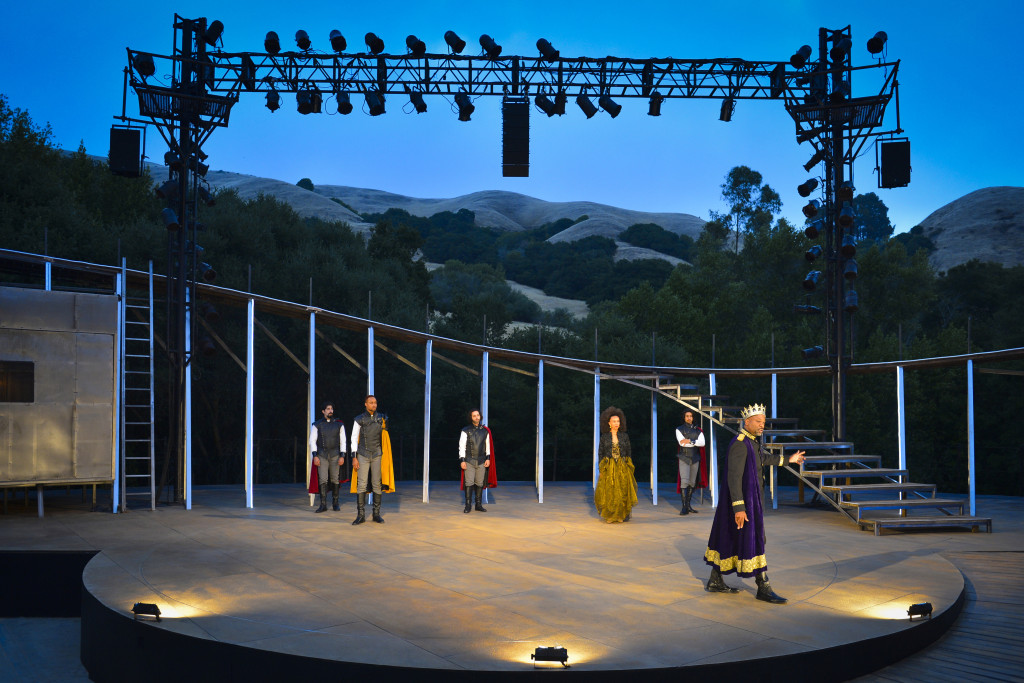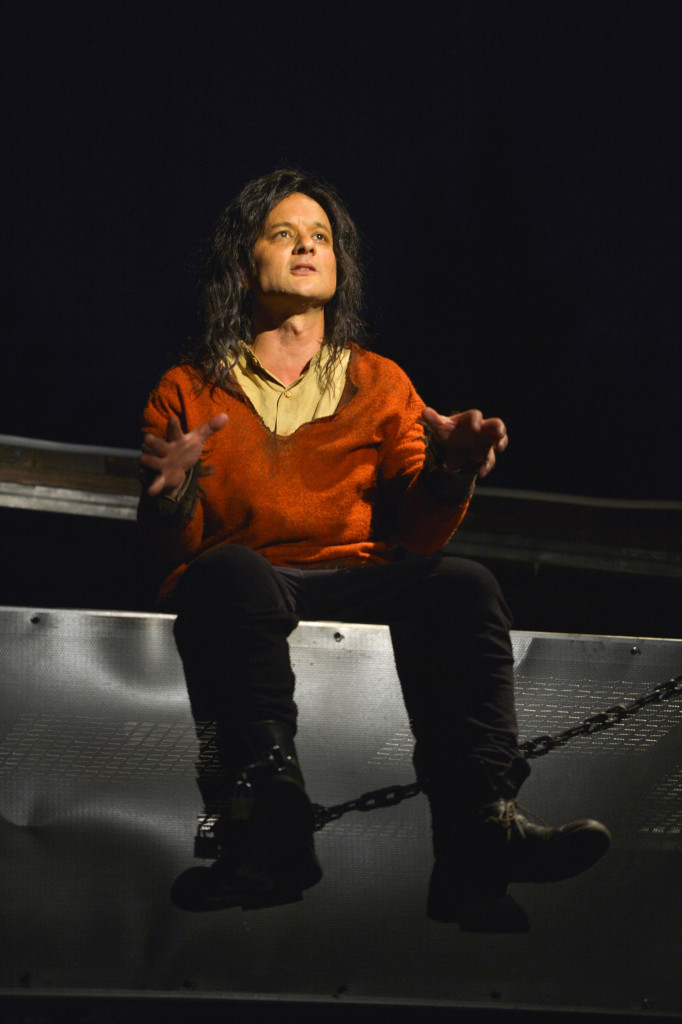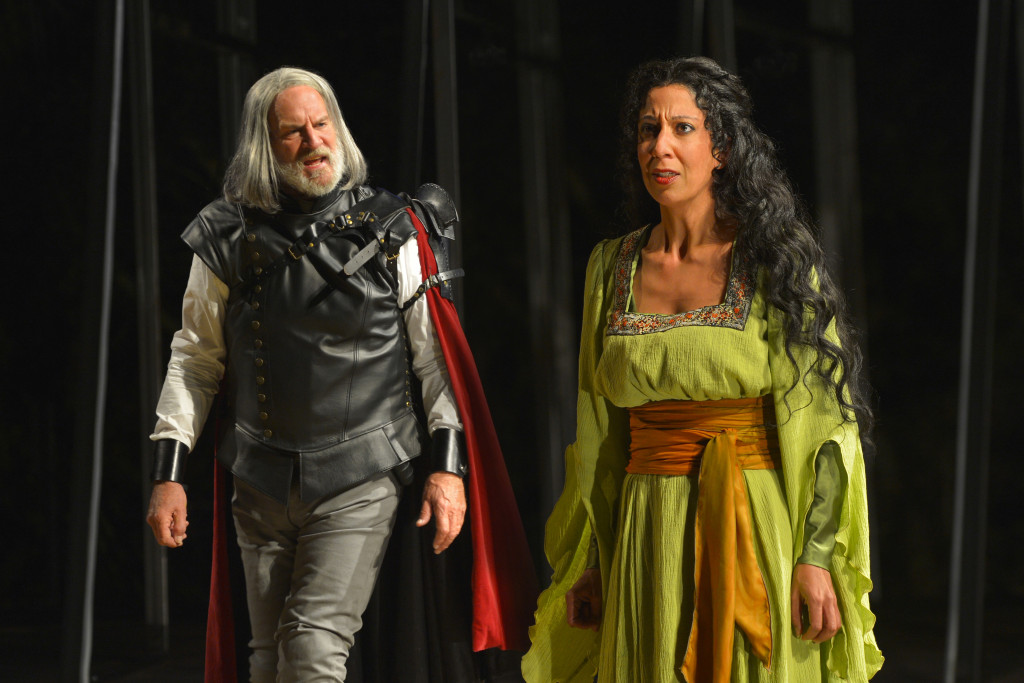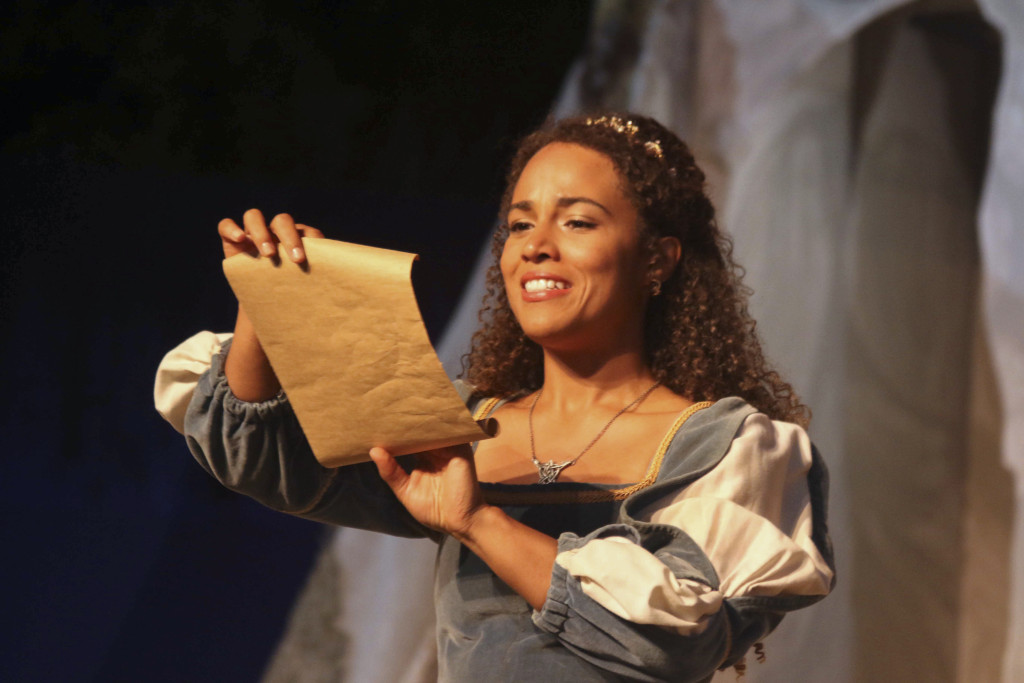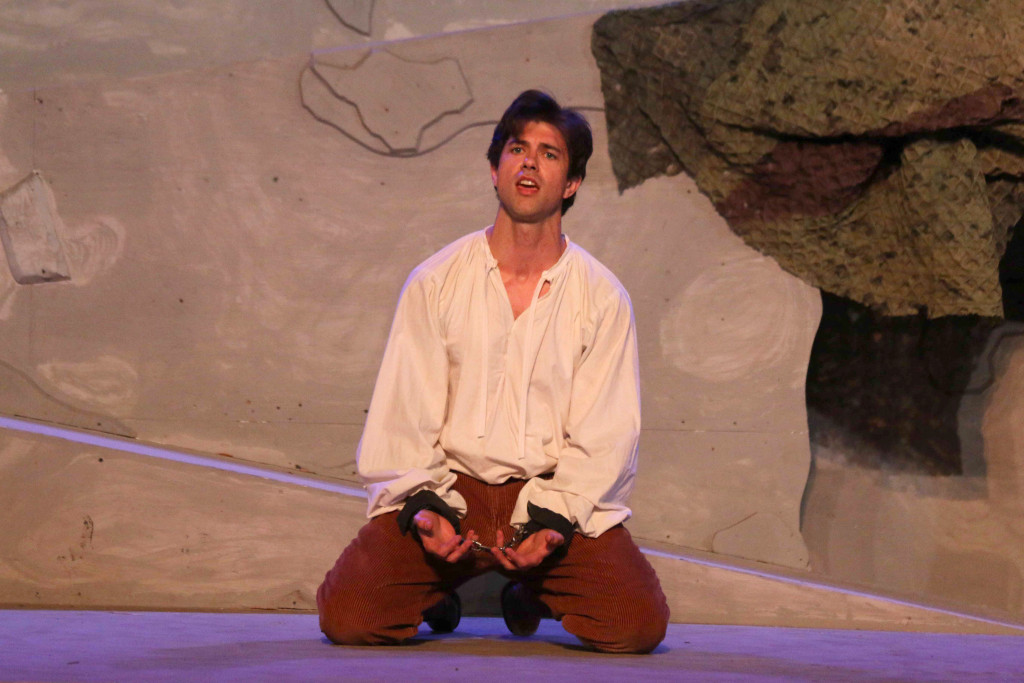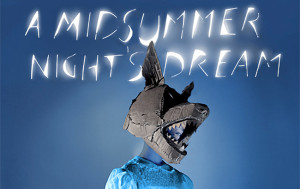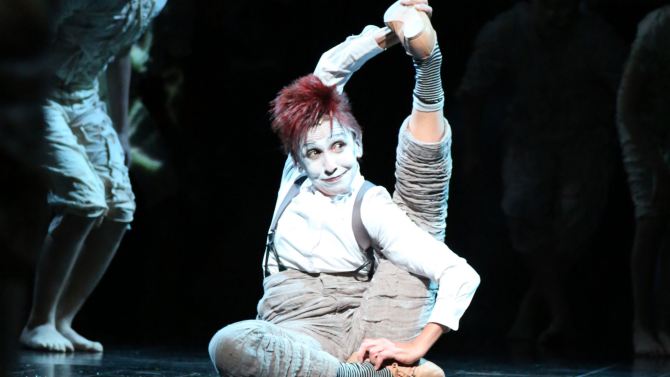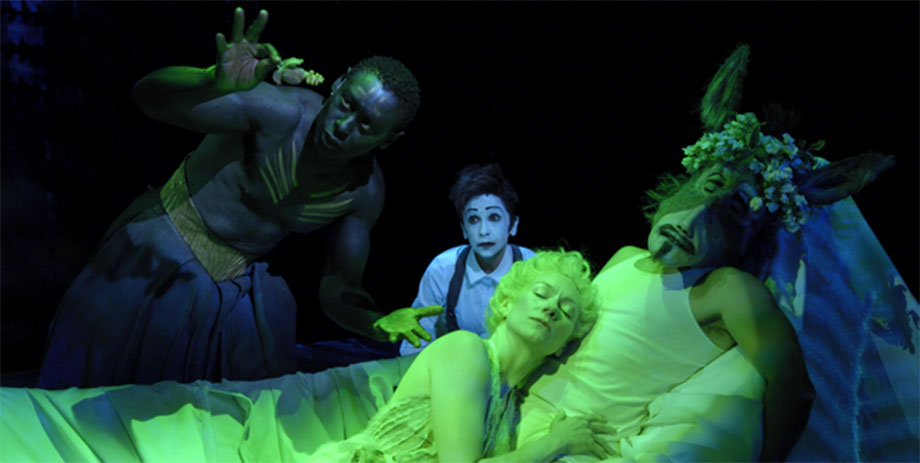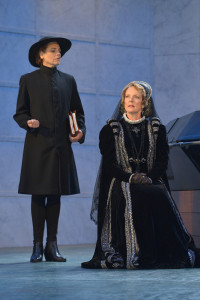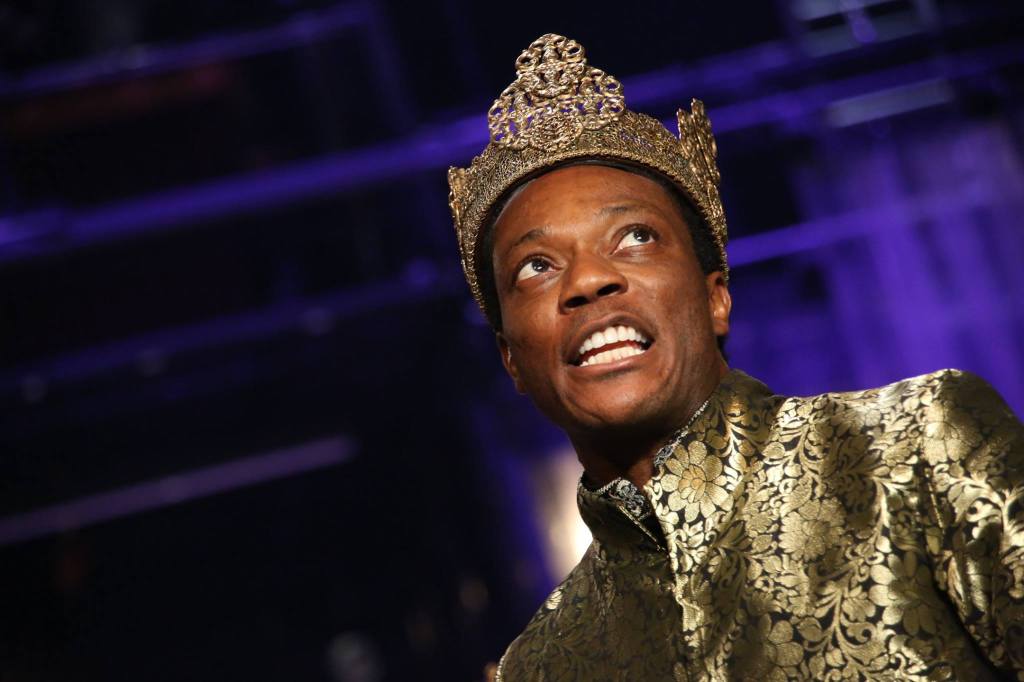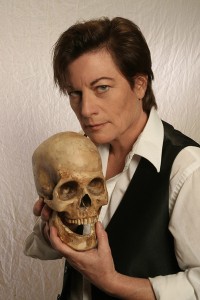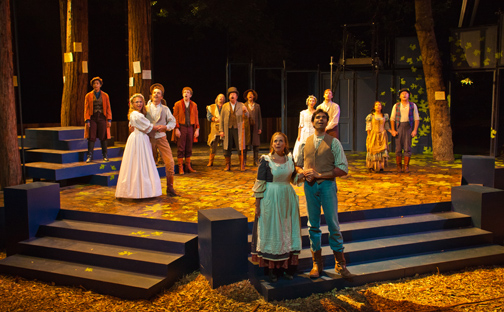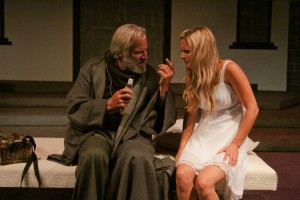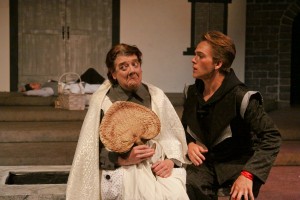A Woman’s World: A Review of AS YOU LIKE IT at the Livermore Shakespeare Festival
July 21, 2015 § Leave a Comment
If this season is the “Year of the Woman” among Bay area Shakespeare Festivals then surely the Livermore Shakespeare Festival, with its female leadership team (Artistic Director Lisa A. Tromovitch, Managing Director Katie Marcel) deserves particular notice. Although they have done nothing to draw particular attention to it, it is worth observing that this summer the festival has an all-female directing staff (Tromovitch and long-time company member Jennifer Le Blanc) and a female-centered repertoire (Sense and Sensibility, As You Like It).
[Note: Managing Director Katie Marcel has pointed out that, although she describes it as a matter of chance and not design, the Board of Directors is also all-female.]
Women Leading
The company is certainly on the move. Tromovitch is the recently elected President of the International Shakespeare Theatre Association and has worked steadily to raise the profile and professionalism of her company over the last five years, including a change for this season to Wente Vinyards as a performance venue.
That new venue provides the key to Tromovitch’s production of As You Like It. Performed on an elevated platform with essentially no scenery and completely surrounded by the audience, the opening night performance had an unforced rapport between the performers and the audience reminiscent of the original conditions for Shakespearean performances. The audience was very close, and never treated as if they were in a separate space. It helped (a lot) that no matter where you sat, audience members were in your direct line of sight across the stage from you. Actors freely passed through the audience for ALL entrances, and those not currently onstage frequently popped into empty seats here and there to watch the show with us.

Michael Wayne Rice as Jacques and the cast of As You Like It.
Costumes by Barbara Murray.
Photo by Gregg Le Blanc, CumulusLight.com.
The resulting casual tone was perfect for just knocking back and enjoying the show, aided by the fact that nearly everyone there was enjoying a glass of wine while they watched. The comfort and ease of the audience interaction was a stark contrast to most Shakespeare, indeed most theatre, that I see where the audience is strongly controlled and subtly intimidated. Here, it was easy to forget that you were watching a four hundred year old play by the-greatest-writer-that-ever-lived. It felt as easy going and enjoyable as a community picnic.
Tromovitch’s take on the show was essentially conservative, with period-ish costumes with a folk flavor designed by Barbara Murray, although she did adopt a very original approach to the dramaturgically troubled ending of the show that surprised and delighted. Her point, however, was not to comment on the show but to fulfill it. Thanks to leading lady Maryssa Wanlass, it was the most emotionally present and engaging AYLI I have seen in some time. Her chemistry with Joseph Salazar (as Orlando) was as fresh and delightful as that of the latest summer rom-com.
A Fiendishly Difficult Favorite
As You Like It is a popular favorite among Shakespeare’s comedies, but is in fact fiendishly difficult to get right. It employs the most music of any Shakespeare play, has a rather unfocused, meandering plot, and typically ends with a literal, and essentially unexplained, deus ex machina in which the god Hymen arrives to set things right – an incident treated so casually that one might assume these characters just interact with gods daily. Things can, and often do, go wrong on all three fronts.
Tromovitch tackles all three of these challenges with a single unifying device – the continual foregrounding of singer Sean Patrick Nill as a kind of metatheatrical narrator. In his hands, often accompanied by other cast members vocally and on instruments, the music is aesthetically engaging while used to tie the story together. When he subsumed the role of Hymen at the play’s end – because he had seemingly been manipulating the story from slightly outside and above the play all evening – it, for once, made sense!
Layers of Plot
The plot is complicated: a dispossessed young man, Orlando, falls in love with the beautiful niece of his corrupt Duke, but is so green and awkward he falls back on clichéd love poems to woo her. The niece, Rosalind, is herself forced to flee from her uncle, who usurped the crown from her father. To protect herself, she goes into exile disguised as a man. They meet again in the woods where both have fled. Orlando does not recognize her through her male disguise, but agrees to some tutoring from her (in her male persona) during which s/he will imitate his beloved for him in a role-playing exercise. At the center of the play is a scene in which (in the original, a boy-actor playing) a woman who is disguised as a man pretends to be a woman (in fact, herself) in order to teach her leading man how to be more genuine and assertive. It is a feat of real skill to keep all these levels clear – especially when the characters get them confused. Tromovitch handled this scene as cleverly as I have ever seen it, with Salazar’s befuddled Orlando becoming increasingly confused about who, exactly, he is falling in love with – the girl or the boy.
Things work out predictably for the couple, and for several other couples that provide variations on the theme in a series of related subplots, but not until the inevitable ending has been delayed as long as possible by the loose diversions found in a summer paradise.
It takes a lot of work to make this all happen but Tromovitch achieves it all with such a light touch that her direction is essentially invisible. Looking back, the engaging evening flew past but felt as indulgent as a chocolate truffle. Strong performances from Patrick Andrew Jones as Orlando’s reforming older brother, William J. Wolak as his faithful servant, and Lindsey Marie Schmeltzer as an overly proud local yokel who falls in love with Rosalind’s male alter ego proved high points.
The cast was not universally strong, which showed particularly in some unconvincing doublings that were neither executed with versatility on their own terms nor justified in their undisguised reuse of actors by a performance convention. Also, as is often the case, some of the more dated farcical parts of the play that have lost their point over time became strained searching for a laugh.
The performance had far more strengths than weaknesses, however. It was a perfect match of venue and play – a light midsummer comedy in an intimate, casual park-like setting. Only the hardest of hearts could possibly resist the swift and glorious ending.
A Company to Watch
Perhaps it is assuming too much to think that the marvelous sympathy between directorial approach and the leading actress’ strengths has anything to do with their shared gender. Maybe it is just Tromovitch’s directorial skills, and not her particular insights into this woman-focused play, that get the tone of this intricate comedy so right. Conceivably, the particularly invitational, friendly environment established in the new venue is the product of good audience engagement research and has nothing to do with the sensibilities of an all-female management team. It is worth contemplating, however, whether more than coincidence is at work. Let’s keep our eye on Livermore Shakespeare Festival to see if women’s leadership continues to provide unique results!
As You Like It
Livermore Shakespeare Festival
Through August 2, 2015
Wente Vinyards, Livermore CA
Seen: July 17, 2015
Dreaming of a Better World: A Review of LIFE IS A DREAM at CalShakes
July 12, 2015 § Leave a Comment
Attending the live theatre can be fun, intriguing, informative, provocative, entertaining, educational… but what keeps me coming back show after show is that every once in a while everything aligns and a night in the theatre is just magical. Such is the case with CalShakes’ beautiful, lyrical production of Calderón de la Barca’s Life is a Dream directed by the brilliant Loretta Greco.
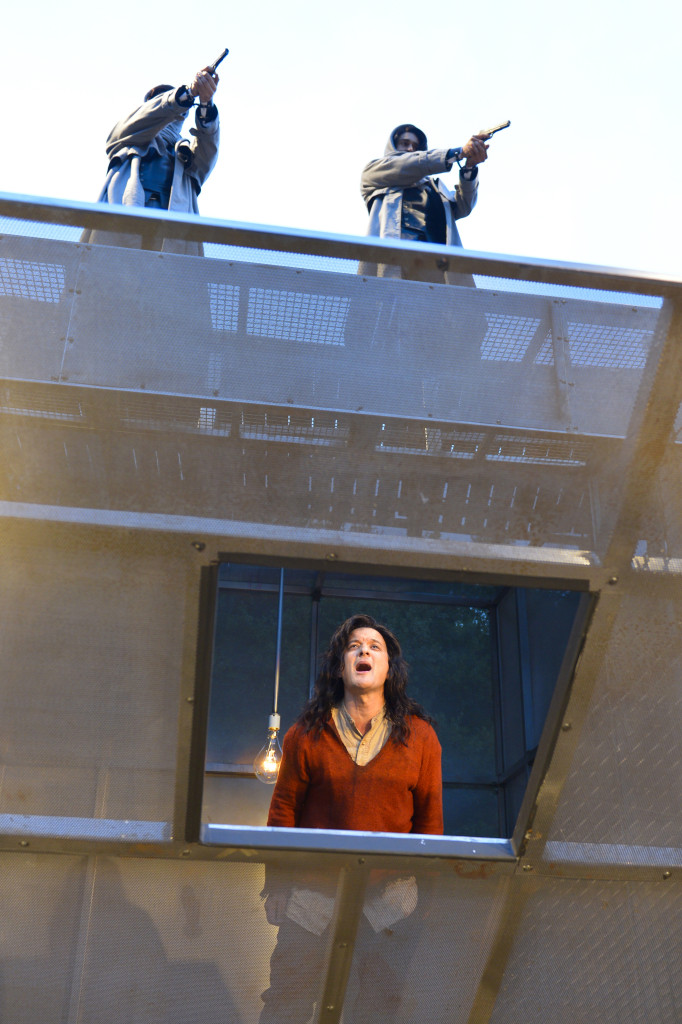
(Above) Carlos Berrera and Kaiso Hill; (below) Sean San José as Prince Segismundo in California Shakespeare Theater’s Life Is a Dream, directed by Loretta Greco; all photos by Kevin Berne.
Anything but Dry
Finding the heart of this Siglo de Oro (Spanish Golden Age) masterpiece is not easy. Usually called a “philosophical drama,” it is, on the rare occasions when is performed, often cold and mechanical. The opposite was the case here. Pulitzer-prize winner Nilo Cruz’ (Anna in the Tropics) translation and adaptation was a key to capturing the shimmering other worldliness – that quality that was later to be called “magic realism” – that permeates the original, but seems so elusive in English.
(That the drama of the Spanish renaissance is so shamefully neglected on the stages of Shakespeare festivals – despite the fact that here on the West Coast a plurality of the population is of Hispanic heritage – especially when French farce is such a staple, is a rant for another day. For now, let me just honor Artistic Director Jonathan Moscone’s opening night statement that it is exceptionally difficult to find the right artist to “unlock” these plays. Greco is absolutely the right artist!)
A Son Betrayed
La vida es sueño tells the story of a crown prince, Segismundo, imprisoned and isolated from birth because ill-omens suggested he would become a oppressive tyrant and overthrow his father, who is drugged and brought to court for one day as a test before one of his cousins is named heir in his place. It is a test that he fails miserably, having known nothing but a brutish, caged existence. The tiny bit of education and philosophy given him by his sole caretaker, a nobleman named Clotaldo, cannot steer him through his first encounters with luxury, power, and especially with the lust he feels when he encounters women for the first time. After a disastrous day, he is again drugged and returned to his cell, where he is led to believe that it was all nothing but a dream. Clotaldo suggests that what he can learn from his “dream” is that it is important to strive for goodness and mercy at all times, even where it seems one has no control.
Segismundo’s existence having become known, however, sets off a civil war and he is freed by his people who refuse to accept the rule of the foreign-born cousins. Now unable to distinguish what is real and what is imaginary so reliant only on pure principle, Segismundo successfully leads the rebellion and conquers the father that has so painfully betrayed and abandoned him, leading to a stunning final encounter.
Otherworldly Beauty
Cruz’ translation and Greco’s production set this story indefinitely in both time and space. Andrew Boyce’s graceful set is a single platform that spirals into the sky above a plain metal box that serves as a cell. Guns and steel suggest the time is not “then,” while capes and swords suggest that it is also not “now.” No geographical references occur at all. Alex Jaeger’s vaguely period costumes and the crystalline illumination by Tony-award winning light designer Christopher Akerlind create a world that is both accessible and ephemeral.
Greco does not make any contemporary references explicit, but the inescapable parallels to repressive regimes, betrayed generations and the seeming unreality of much of modern life float forward anyway. A light touch has a huge impact.
Stunning Cast
Segismundo is usually played by a Hamlet-like tragic hunk, but the revelation of the night was the extraordinary central performance by the man-child Sean San Jose. His simple awe at everything he encountered coupled with his quick, deep connection to his emotions made his transcendent performance moving beyond description.
The moral center of the play is Clotaldo, caught between loyalty to his king and his duty as caretaker to Segismundo. Julian López-Morillas, an artist with long and deep ties to this community, brought to the role the same intensity and humanity that illuminated his revelatory performance as Geronimo in Marin Shakespeare’s The Spanish Tragedy two seasons ago.
Performances of the play usually fall apart around the tangential sub-plot about a young woman seduced and spurned by Segismundo’s cousin, Astolfo. Never having known her father, and unable to find any champion, she sets off in male disguise and with a comic side-kick to seek revenge, where she encounters Segismundo in his prison and eventually finds her real father and her destiny. Even bravura performances often fail to make the role rise above the improbability and coincidence.
In the hands of Sarah Nina Haydon, however, this Rosaura becomes something else. She finds her own suffering parallel to Segismundo’s, not least because of the way that it keeps intensifying through circumstances that she experiences as surreal. Her life is as nightmarishly dreamlike as is the protagonist’s, and as revealed by the delicate handling of her performance under Greco’s direction, as ours.
The cast is uniformly superb. Amir Abdullah is charismatic as the complex cousin Astolfo. Company favorite Tristan Cunningham has never been better utilized than she is as the radiant competing cousin Estrella. Adrian Roberts is a commanding presence as the conflicted king. Jomar Tagatac is by turns hilarious and then devastating as Rosaura’s pragmatic side-kick. Even the unnamed parts were fulfilled brilliantly by Carlos Barrera, Kaiso Hill and, especially, a compelling Jason Kapoor – whose reappearance in multiple roles rose above utilitarian and became yet another element that made the production feel dreamlike.
Another Dream Play
When the play finally reaches its climax, with the conquering Segismundo facing down his self-serving father, honest but inadequate tutor, love-interest who is in love with somebody else, and scheming cousins, the adaptation by Nilo Cruz takes an unexpected turn away from the predictably mundane resolution of the plot and leaps into the poetic heights reminiscent of Shakespeare’s dream play, Midsummer. It is a gasp-inducing conclusion that feels perfectly suited to the cultural moment. Theatre does not get better than this.
Life is a Dream
Playing through August 8, 2015
California Shakespeare Theatre
July 11, 2015
Forgiveness After All: A Review of CYMBELINE at Marin Shakespeare
July 4, 2015 § Leave a Comment
Shakespeare’s brilliant but rarely-produced gem, Cymbeline, is receiving a wonderful new staging by the Marin Shakespeare Company (with a terrific new musical score by Billie Cox) that makes you wonder why this play is so rarely performed.
Tales of Reunion and Redemption
Cymbeline is one of Shakespeare’s four late tragicomedies, collectively known as the Romances. (The others are The Tempest, Pericles and The Winter’s Tale.) Their essential quality is the way in which they seem to shift genre as they progress from darkest tragedy to hard-won, but happy, endings.

The full cast on Jackson Currier’s evocative set for the revelatory final scene. All photos by Lori A Cheung
The titular character of Cymbeline is the king of Britain during the time of Caesar Augustus, but he is a relatively minor character in the play. The protagonist is his daughter, Imogen, a role with such range and variety that it is known as the female Hamlet.
Enough Plot for Ten Plays
The plot is enormously convoluted, even by Shakespearean standards, but essentially traces her fortunes after she marries (over her father’s, and especially her wicked step-mother’s, objections) her poor-but-valorous childhood sweetheart, Posthumus, in preference to her cloddish step-brother, Cloten. For ruining Cloten’s path to the kingship, Posthumus is banished, makes his way to Rome, and in a self-pitying drunken episode is persuaded to wager on his wife’s fidelity. Through the trickery of a Machiavellian villain named Iachimo, he is convinced that she is unfaithful to him, so he puts a hit out on her.
Meanwhile, she secretly travels to Wales, where she believes she will be reunited with Posthumus. Once informed by a sympathetic servant that she has been lured there to be murdered, she goes into male disguise and falls into company with a long-banished courtier (now gone Celticly native) and the two young men he is raising as his sons. After additional plot twists and turns, she awakens from a Juliet-like artificial coma to discover a headless corpse next to her dressed in her husband’s clothes, at which point she has a famous freak-out scene. Against the background of a battle between the native Britains and the occupying Roman Legions (who have conscripted both Posthumus and Iachimo into their service) the circumstances are aligned for all to work out, but no character has access to all the facts.
The play ends with a wildly improbable, and therefore wondrous, final scene consisting of some thirty+ revelations, as individual characters slowly realize they know a crucial piece of information and steadily trump each other with escalating plot twists that take in deathbed repentences, mistaken identities, long-lost children, and finally (beautifully! magnificently!) forgiveness and reunion.
Marin’s version is streamlined, shortening one of Shakespeare’s longest plays into a comfortable two-and-a-half hour playing time. Some presentational moments of paraphrase of plot points apparently thought too obscure were unnecessarily colloquial, coming off as condescending instead of comic, but they did get us moved on to the meat of the show.
Overlooked Masterpiece
Cymbeline is shamefully neglected and under-produced, historically because plays with female protagonists were thought, incorrectly, to lack drawing power – ironically the very same debate currently raging over Hollywood blockbusters. At the moment that tide was finally beginning to turn, the sheer demands of size and scale of this enormous play began to make it undesirable in the increasingly impoverished circumstances of the American theatre. Marin Shakespeare, the little-company-that-could, is far and away the most programmatically adventurous in the Bay Area and seems completely undaunted by either threat.
As Imogen, Stella Heath brings the range and the stamina the part demands, along with an enormously sympathetic appeal. She is the glue that holds this production together, and is a great standard bearer for Marin in what is turning out to be “the summer of women” at Bay Area festivals. Thomas Gorrebeeck pulls off the theatrical tour-de-force of playing both the hero, Posthumus, and the antagonist, Cloten. His Posthumus is suitably hunky and believably gullible, diametrically contrasting with his rather unnuanced portrayal of the nuance-free dolt, Cloten – but scores the most memorable moment in the production when (in an incongruously inserted rock song) he proves he has the moves like Jagger.
The cast has several other standouts, including Davern Wright as the smarmy, and then astonishingly guilt stricken, Iachimo; Rod Gnapp in the wildly difficult role of the courtier-turned-mountain man Belarius; and the amazing local favorite Debi Durst, who may have the most expressive face in the Bay Area, and without whose astonished range of reactions in the final scene we might have been totally lost.
Billie Cox has added a set of original songs, using Shakespearean lyrics, with a generally pleasing Celtic quality that seem both authentic and efficient. (A few less impressive modern digressions were not to my taste – the most egregious of which was the insertion of “That’s Amore,” with both original lyrics and then a reprise with a set of juvenile alternative lyrics that fell flat, but those moments passed quickly while the impact of some lovely ballads and love songs lingered.) Jackson Currier’s set is the best that this generally spectacle-eschewing company has utilized for years, and Tammy Berlin’s costumes are more than serviceable.
Transcendence After All
Robert Currier’s direction was generally sound and inventive. The opening expositionary moment of the show, usually a dull recitation of facts, featured a stroke of genius: the staging included a bed rolling across the stage as its inhabitants (Imogen and Posthumus) were introduced. He also moved huge crowds about the stage, not just efficiently, but in ways that pictured the complex story clearly.
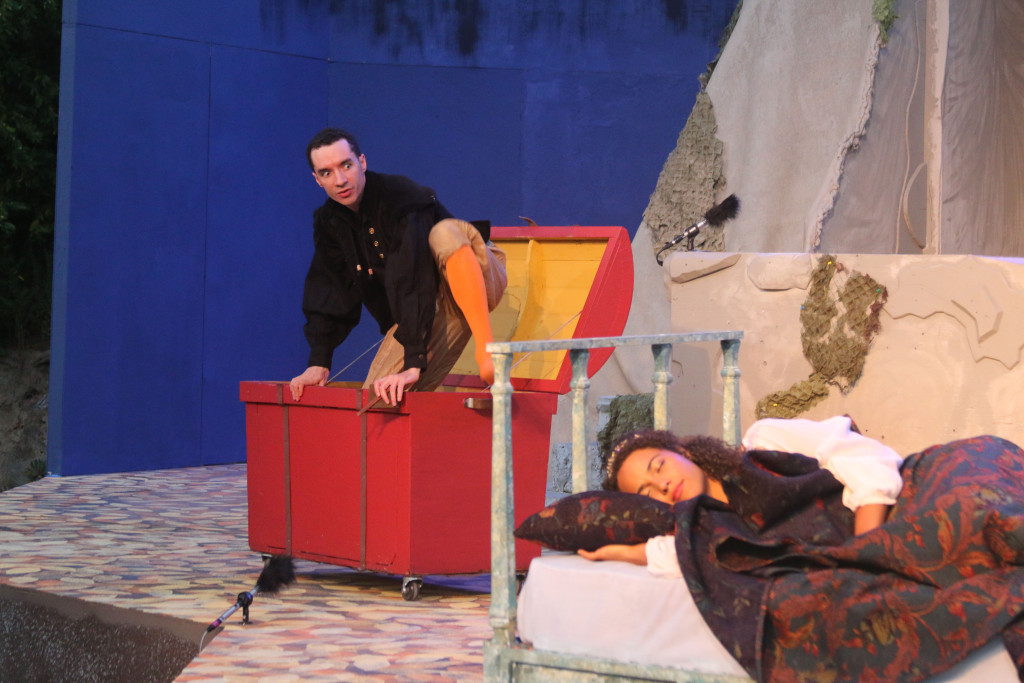
Davern Wright as the Machiavellian Iachimo after having smuggled himself in Imogen’s bedroom in a trunk.
His control of tone was shakier, as he seemed particularly concerned not to let the early parts of the show become too serious although their tragic threat is exactly what makes the final dodging of death and destruction work. As a result, many of the antagonists seemed comic stereotypes instead of credible obstacles. The real loss of the evening is that the combat, staged by Richard Pallaziol, seemed under-rehearsed and amateurish compared with the rest of the production.
However, whatever quibbles I have with the progress of the show cannot diminish the overall accomplishment, especially the transcendent final scene. With the still-stinging pain of Charleston on our minds, one could not help but think of the powerful moment of forgiveness offered by those grieving families when Posthumus – faced with similar villainy – uttered the beautiful line, “Kneel not to me./The power I have on you is to spare you,/The malice toward you to forgive you. Live,/ and deal with others better.”
Cymbeline
July 3 – 26
Marin Shakespeare Company
Seen July 3, 2015
Julie Taymor’s A MIDSUMMER NIGHT’S DREAM: a review of the film
July 1, 2015 § 1 Comment
Julie Taymor’s acclaimed production of A Midsummer Night’s Dream for Theatre for a New Audience is now available in a fascinating new film, and it is well worth seeing both for her ideas about the play and about plays on film.
A Play and a Film
Because MND is so much about the theatre itself, it is not a surprise that Taymor has eschewed the location shoots she adopted for her previous Shakespeare films – Titus and The Tempest. This film records her production inside the theatre where it was performed live, capturing the visual splendor and relentless inventiveness for which she is known, but it is quite different than the relatively static live broadcasts of plays for which Britain’s National Theatre has recently become known. Taymor uses a lot of filmic techniques. Cameras on stage capture the action from extremely close distances and viewing angles that no live audience member could ever experience, and (especially at the beginning of the film) the cameras are so active as they quickly pan around the crowded stage that they give the impression of being active participants. At other times the camera becomes such a close confidant of the actors, especially David Harewood as Oberon, that the style of the acting shifts to the whisperingly cinematic.
Occasionally you get a more traditional view of the stage, usually when Taymor is recording the interaction of actors and the extraordinary projections on floating silk banners and canopies that astounded the live audiences in Brooklyn. As impressive as these shots are, this alternation between the conventions of film and theatre is sometimes disconcerting.
Kathryn Hunter, Genius
Both the production and the film are completely built around the performance of the remarkable Kathryn Hunter as Puck. She opens the film as an exhausted sleeper drifting off into dreams, and when the rude mechanicals (as modern dress Brooklyn construction workers) show up and cut her bed free she literally drifts into the grid above the stage like a balloon. Her first full scene, with what is ordinarily a single fairy but is here a full cast of children who sing and chant the scene, establishes her distinctive childlike voice. Her wide-open wonder plays especially strongly in her scenes with Oberon, where she idolizes him like a parent–sometime fearful and sometime delighted to be pleasing him. It is the most fully imagined and realized Puck I have ever seen. For her performance alone, the film is worth your time.
The film is not without theatrical and cinematic flaws. Taymor is frequently more concerned with the big picture than the detail – and almost always prioritizes the visual over the auditory. The sound appears to have been captured through body mics, but sometimes you hear the faint echo of an additional actor’s mic. Often the scansion is sloppy. (At one point the possessive form of Theseus’, which should be two syllables, thes-yus, is rendered as four: Thes-e-us-es!)
Multiethnic and International
The production is especially interesting in the realm of the supernatural, where Taymor’s visual genius prevails, while the “real” world is more mundane. Unfortunately that is not just because the visual presentation is more restrained. It seems the interpretive act was just less interesting to Taymor. The lovers were trivialized, with only Mandi Masden as Helena making an impression, and the admirably multiethnic mechanicals were largely conveyed through broad stereotypes. Max Casella was amusing as a Brooklynese Bottom, but (as is often the case) Flute steals the show from him. In this case it is Zachary Infante’s Spanish speaking Francisco Flute that unlocks the wonder of Shakespeare’s power, as he discovers the ability to invest words he scarcely understands with meaning and power.
The most interesting casting of the evening is Okwui Okpokwasili as the conquered Queen Hippolyta. Both the gender and racial politics of the part were treated lightly, but her powerful presence was more than enough to make the point.
Finding the right level for a film of a play is a complex task. This relatively complete production of the script is FAR more satisfactory than Michael Hoffman’s disappointing, choppy 1999 film, and in many ways is also more pleasing than Adrian Noble’s similarly mixed film/play (1996) of his RSC production, if only because it utilizes more interesting theatrical conventions.
The film is in limited release, but absolutely worth catching on a large screen whenever you can.
Top Girls: A Review of TWELFTH NIGHT at CalShakes
June 2, 2015 § Leave a Comment
With its almost-all-female Twelfth Night, CalShakes has set a very high bar in what is emerging as “the summer of the woman” among Bay Area Shakespeare Festivals. Concerned with the lack of opportunity traditionally cast productions offer women, both the San Francisco Shakespeare Festival and Santa Cruz Shakespeare have announced they will perform with casts that have gender parity. Sacramento Shakespeare is performing an all-female As You Like It (along with an all-male Romeo and Juliet), and even companies with more traditional approaches seem to be producing an unusual number of plays with featured female protagonists this summer.
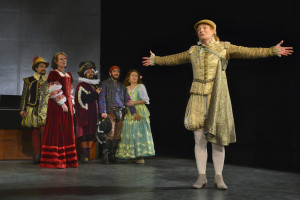
Lisa Anne Porter as Viola and the cast of California Shakespeare Theater’s production of TWELFTH NIGHT, directed by Christopher Liam Moore; photo by Kevin Berne.
The Challenge of Cross-Gender Casting
Achieving more opportunities for women is not as simple as it sounds, however. Shakespeare’s plays (written originally for an all-male troupe) have a limited number of female roles – four or fewer per play – in comparison to the dozen and up male parts. That number might be improved slightly because occasionally there are parts that do not really have a gender, like the narrator, Chorus, from Henry V, that can be easily cast with women. And there are numerous small roles that can be re-gendered safely, but how great a break-through is it to be allowed to play “2nd servant” in a dress? Such condescension is often more objectionable than not being cast. Finally, of course, there is the possibility that some women can undetectably pass as males, but that is a very limited casting pool and is not the opportunity of which most actresses dream. There are, therefore, a very limited number of ways that one can produce the plays, at least in a traditional way, that does much to address the problem.
The exercise only becomes interesting for both audiences and actors when women play “male” roles from their own viewpoint, bringing fresh and exciting perspectives to narratives about which we have grown complacent. Last fall, in her terrific solo show, Shakespeare and the Alchemy of Gender, the great Lisa Wolpe demonstrated a knack for imitating the physicality and vocalization of men – especially tragic heroes – but became revelatory when she assumed (and simultaneously “commented” upon) the attitudes of male privilege. What makes her so exciting as our reigning “Shakespearean drag king,” is that we never lose sight that she is a woman who sees how “maleness” is constructed and rewarded, and not that she does some kind of perfect impersonation.
A Man Among (Wo)Men
CalShakes takes a much more light-hearted, but no less revelatory, approach in its beautifully rendered Twelfth Night. Director Christopher Liam Moore finds myriad ways for his cast of seven women and one man to illuminate the play’s thematic gender confusion. Ted Deasy, making his area debut but familiar to many audience members from his work at the Oregon Shakespeare Festival, is cast as the jester, Feste. He also doubles virtually every unnamed character in the play (the Captain, the arresting officer, the priest, etc.). Deasy is nothing short of brilliant as the fool and entertainer – rendered as a purposely anachronistic country and western singer. His portrayal of Antonio, the sea captain hopelessly in love with the young man he saves from drowning, is heartbreaking. His finesse at playing multiple roles, sometimes simultaneously (as when he hilariously arrests himself), is the stuff for which one would ordinarily praise this production to the skies. (Deasy, the only man in the cast, playing ALL the drudge roles is, in itself, an interesting comment.)
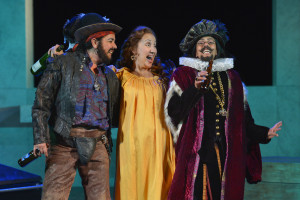
(L to R) Catherine Castellanos as Sir Toby Belch, Domenique Lozano as Maria, and Margo Hall as Andrew Aguecheek. photo by Kevin Berne.
Beards
Outstanding as he is, however, it is the women who rock the night. Catherine Castellanos, whose Toby Belch is all codpiece, gives an incisive portrait of a particular kind of male cloddishness. The falseness of her false beard is quite pointed – her aim is not sincere imitation, but satire. Her partner in crime is the brilliant Margo Hall, whose Sir Andrew Aguecheek is so effeminate that we cannot help but see how artificial our gender constructions can be. Hall is hilarious, precisely because of the incompletely digested gender codes her character displays. Remi Margron completes the trio of false-facial haired characters with a love-sick Orsino whose emotional range was far greater, and more convincing, than any that I can ever recall seeing.
And a Lack-Beard
Perhaps the most interesting creation of the night was Stacy Ross in the role of Malvolio. Unlike the bearded bunch, she was costumed and made-up in a way that scarcely bothered to nod toward maleness. Hers is not a particularly masculine face, and no attempt was made to alter it or her figure. If anything, in fact, her cassock looked (as they inevitably do) rather like a dress. The character was intensely interesting because the focus on her puritanical nature had almost nothing to do with gender at all. Later, having fallen prey to the deceitful trick that made her believe her mistress was infatuated with her, it was her shocking lack of a male conception of masculine display that provided the humor (and, of course, the larger commentary) as she writhed around in her yellow garters and a strategically placed giant yellow bow.
Women Playing Women
The cast also featured women in the traditionally female roles, particularly Julia Eccles as Olivia, and Domenique Lozano as Maria, and the contrast was exquisite. For once, one sympathized with Olivia’s impatience with Orsino’s relentless onslaught. In contrast to him, her maturity and composure were striking. All the more powerful, then, was the effect of her coming unglued at the sight of Cesario, who is actually the disguised Viola. One also understood that Maria was saving Toby, not simply failing to see through him.
The evening turned on the performance of Lisa Anne Porter as both the twins Viola and Sebastian. Except for their attitudes toward fighting, almost nothing distinguished them, which turned out to be the best decision of the night. Viola is already “playing a man” in her disguise as Cesario, which we often feel in performance she is not doing very well because a very distinctly male person is being directly compared to her every time Sebastian comes onstage. In this case, however, the twins were truly identical – and the artificiality of gender constructions was highlighted in a way I have not previously experienced. The reality of what Viola was giving up by trying to live by men’s rules was heartbreaking, and the ease with which her brother was granted everything he wanted without so much as asking for it was shocking.
The manner in which the play resolves, in a scene with both twins onstage, was well-handled directorially and perfectly appropriate for the play, but was less surprising than it might have been to anyone who saw the company’s production of Comedy of Errors last season, which used the same convention and virtually the same staging for its final moment.
The Spice of Life…and Art
It would be a mistake to suggest that the performance was didactic about its non-traditional casting. Far from it; it was subtly employed in a marvelously entertaining evening. Nonetheless, successful cross-gender casting is challenging. What was so smart about this particular production is that almost as many approaches as cross-gendered parts were employed. It was the variety that most amazed, and in the end, spoke most eloquently for the practice.
Nina Ball’s beautiful set, a sleek family crypt with an ever-present coffin to remind us that the play is essentially a memento mori, was stark and efficient. It featured a large central opening that allowed us to see Burke Brown’s beautiful lighting of the natural landscape in the distance as well as his subtle and effective illumination of the action. Along with Meg Neville’s delightfully detailed period costumes, the visual element helped explain – along with the adventurous non-traditional approaches it has repeatedly employed – why CalShakes has emerged as the premiere classical company in the Bay Area. Performances continue through June 21 – plenty of time to see this highly recommended production.
Details:
Twelfth Night
Presented by the California Shakespeare Theater
Bruns Amphitheatre, Orinda, CA
May 30, 2015
The Mask of Blackness: The Arabian Shakespeare Festival’s OTHELLO reexamines Moorishness.
November 15, 2014 § 2 Comments
Otherness comes in many flavors
Since the extinction of the practice of white actors performing (and stereotyping) the title role of Othello in blackface, the play – at least in America – has featured actors of color and become a vehicle for examining black/white race relations. Because that is a necessary, and still unresolved, conversation it has been a highly successful strategy for rediscovering the relevance of the play.
What got lost in that transition is the possibility that Shakespeare was dramatizing otherness and ethnicity, but from a different perspective than Americans are imposing on it because of our current cultural complications: Othello is identified as a Moor, a word more closely associated in the Elizabethan era with those of Arabian descent than with peoples from sub-Saharan Africa. At about the time Shakespeare was writing the play, in fact, Elizabeth was receiving a famous embassy from the Barbary States. The ambassador, who manners and dress captivated London, took time to have his portrait painted.

Abd el-Ouahed ben Messaoud ben Mohammed Anoun (Arabic: عبد الواحد بن مسعود بن محمد عنون) was principal secretary to the Moroccan ruler Mulay Ahmad al-Mansur, and ambassador to the court of Queen Elizabeth I of England
The San Francisco-based Arabian Shakespeare Festival is now producing the play in a version which, unsurprisingly given its mission, opens the conversation about the Anglo/Arab implications of the play. The eight-person cast, led by Armando McClain, is mostly composed of accomplished regulars with various troupes in the active Bay Area Shakespeare scene.
The company is an emerging group, still producing on a shoe-string – albeit in an Equity approved project. Performing currently in the Royce Gallery’s intimate space, (the production will later tour to the United Arab Emerates, I think) the set is a modern adaptation of an Elizabethan open stage, cleverly incorporating two large support pillars into the downstage location similarly occupied in the Globe. The scenery, by Janny Cote, consists of a few sliding cubes and a couple of curtains. (These were hung from an incongruously omnipresent palm-ish tree, center stage, which may allude to the symbol of the desert tribes, but because it lacked any direct purpose was – at least to me – confusing.) Joanne Martin’s costumes were suits and uniforms for the male characters, dresses with prominently featured head scarves for the women. The time and place was the modern Middle East.
Performing in an American/Arabian Context
Kevin Hammond’s direction is understated, and as far as creating visually interesting groupings of the actors, essentially absent. The production, therefore, hangs on the performance of the actors, and on the inescapable contemporary implications arising from the company’s American/Arabian context.
On the performance front, the production is an unmitigated treat. In almost any production McClain’s beautiful vocal production and outstanding diction would stand out, but Teddy Spencer as Iago, Jennifer Le Blanc as Desdemona and Artistic Director William J. Brown III as Roderigo easily kept pace. This was far and away the best-spoken production I have recently experienced. For those who go to hear a Shakespeare play, this is what you dream about. The intelligence of the readings, the clarity of thought, and the easy audibility made this production as accessible as any contemporary play. There was never a moment I felt in doubt about what had been said or what was meant.
Spencer’s Iago is especially rewarding. He is a meticulous actor. I previously admired his performance as Orlando in Marin Shakespeare’s As You Like It for its extraordinary clarity, but his Iago is on another plane altogether. The steps by which his plot unfolds, exceeding even his expectations, are so carefully executed that you can feel him thinking in front of you. His Iago is colder than is currently fashionable, which is interesting in the context of Red State America’s xenophobia – he feels no need to seduce us into agreeing with him. Although Spencer is capable of incredible charisma on stage, he does not seek to charm us in this role. Instead, he steadily implicates us in his plot with an expectation that we will share his hatred of the outsider – which is chilling.
Le Blanc is very well known in the Bay Area. Her Rosie-the-riveter-inspired Kate in Taming of the Shrew at Livermore Shakes (opposite McClain as Petruchio) was a powerhouse performance. She is an unusual Desdemona because she is anything but delicate, or helpless. She is a strong actress, and it infuses her characters. Her Desdemona’s fate forces us to think about the issues of women’s rights both domestically and internationally because she is not passively complicit in it. She fights right to the end.
Perhaps the single best performance in the play is Brown’s wonderfully inept Roderigo, whom Iago dupes financially and ultimately murders. From the opening moments he is in over his head, but Brown’s embodiment of his bewilderment, fear, and pliability is a tour de force. It is exceptionally difficult to play weak characters memorably, but Brown’s Roderigo is the best I have ever seen.
Annamarie MacLeod rounds out the principals as Emilia, Desdemona’s servant and Iago’s estranged wife. Emilia has one of the most memorable monologues in Shakespeare, rationalizing why women might cheat on their cheating husbands, but MacLeod delivered it with a vulnerability and yearning for her lost husband that I have never previously seen.
The supporting cast included Malcolm Rodgers, Aaron Kitchin and Sofia Ahmad all of whom had some lovely moments.
A Fresh Context
Conceptually this is not an aggressive production. While the play itself focuses attention on Othello’s outsider status, the implications of the Arabian context in our current climate (where Arab-Americans can be subjected to intense hostility no matter what their religious beliefs or degree of assimilation) unfold subtly and slowly. I, at least, have seen the play so often filtered through the lens of the African-American experience that it took a while to realize exactly how this production was filtered through the American-Arabian lens instead. (There is neither denigration or dismissal of the former in this production, it is simply seen – unusually for our time – through the latter.)
Nonetheless, it gives the play a different feel and focus. For example, near the end of the play Othello receives word that he has been reposted, creating an urgency in his mind to deal with his (in his belief) unfaithful wife before the opportunity passes him by. He might have dealt with things more slowly and rationally if he were not being transferred the next day. And to where? I never really paid attention before, that his transfer is to Mauritania, from which the word for his ethnicity, Moor, is derived. Venice is rewarding his outstanding service by exiling him to a remote outpost where he will “fit in” now that they no longer need him.
Or this: Desdemona introduces the prophetic “willow song” by telling us that her mother’s maid sang it on the night she died. The maid’s name was Barbary – she was Moorish from the Barbary Coast. The number of references to Arabian matters and frameworks is astonishingly high once they are highlighted by design or by context.
Of course, throughout the play many characters (including Othello, himself) also comment on his blackness. This can be understood symbolically, but it has been a long time since I saw an Othello who was not also very dark skinned, so I have hear these references literally instead. (The last Othello I saw who was not very dark skinned was probably Patrick Stewart in a famous “photo-reversed” production for the Shakespeare Theatre in Washington, D.C. in the mid ’90s where everyone else in the cast was African-American.)
I have no idea how Armando McClain self-identifies ethnically, (nor do I think he – or any actor – has any obligation to clarify such matters) but in this production he reads more bronze than black. In this case, that helped me to hear the production as emphasizing the metaphor, the “mask” if you will, of blackness instead of the literalness so often associated with Othello’s and others’ statements. It was useful and interesting to think freshly about the association of darkness with malignancy and the damage done by such connotations.
This is a fascinating and original production of a play which has grown somewhat interpretively stale in the repertoire, and worth the time and effort of anyone that wants to see and hear it with fresh appreciation. It has a short run, and a limited number of seats, so go while the opportunity is available!
Othello
Arabian Shakespeare Festival at the Royce Gallery
Nov. 14, 2014
www.arabianshakespearefestival.org
There Will Be Blood: a review of Marlowe’s TAMBURLAINE, Parts I & II
November 9, 2014 § 4 Comments
Absent Father
Christopher Marlowe was a fast living, young dying contemporary of Shakespeare’s who broke away from the medieval tradition of sing-song alliterative verse and almost single-handedly ushered in the golden age of Elizabethan drama. He was a revolutionary genius, perfecting and popularizing blank verse, a muscular new meter which Ben Jonson called “Marlowe’s mighty line.” He is revered as the “father of English tragedy.” Why, then, are his plays so infrequently produced?
(Doctor Faustus is Marlowe’s best-known work and, I concede, produced more often but still not quite cracking the levels of even minor Shakespeare, but his other plays have essentially dropped from the repertoire in America.)
Although my usual “beat” is the Bay Area, I sought some answers at a recent preview performance in Brooklyn’s Polonsky Shakespeare Center. Theatre for a New Audience is currently offering a rare production of Marlowe’s first great hit, Tamburlaine. How rare? Tamburlaine has not been professional produced in the city during my lifetime, last gracing the boards there in the mid 1950s.
Directed by Michael Boyd (recently stepped down from the helm of the RSC) and starring John Douglas Thompson, the production was illuminating about both the thrill and the danger of reviving Marlowe.
Marlowe’s play, now called Part I, was the hit of the London theatre scene in 1587, and he quickly penned a sequel, Part II. TFANA is presenting a sleek cutting which combines sections from both plays, and bills it as Tamburlaine, Parts I & II. Thoughtful editing by Boyd brought the scope of this evening down to four hours (inclusive of intermission), but that length alone is at least one impediment to more frequent performance. The sheer scale of the material is daunting to both the production company and the audience alike. Whatever compromises were necessary to bring the material down to this length, however, fear of controversy was certainly not a guiding factor as I shall explore a bit more later.
Historical Fiction is not a New Genre
Tamburlaine, like most Marlowe plays, has as its central figure a driven, charismatic anti-hero who refuses to accept the limitations placed on him. Tamburlaine is historical fiction, dramatizing the story of the self-made Tartar Emperor, Timur the Lame, who started life as a poor shepherd and eventually conquered the remnants of Genghis Khan’s empire.
In Part I of the play we watch him rise to power through a combination of fearlessness, charm and treachery, brilliantly conveyed by John Douglas Thompson in the title role.
Tamburlaine is already a successful marauding bandit when the play begins. When the King of Persia (Paul Lazar) sends his disloyal brother (the wonderfully slimy Saxon Palmer) to suppress his piracy, Tamburlaine deftly turns him by elaborately promising to support a coup. Once it is successful, he instantly reneges on his promise by disposing of his new sponsor and taking the crown for himself. (One of the recurrent motifs in Marlowe is the distance between what is said, albeit with rhetorical brilliance, and what is actually done. How depressingly relevant does that remain today?)
It’s All About the Wordplay
He kidnaps the daughter of an Egyptian king, Zenocrate (Merritt Janson) on the way to her wedding, and vows to make her his wife, but delays to test her even after it is clear that she has fallen in love with him. The bulk of Part I is taken with his conquest of the Turks. His verbal duels with Bajazeth, their emperor, (Chukwudi Iwuji giving the best performance in the play) are the high point of the night – Elizabethan trash talk that thrills. Marlowe doubles down on the delight by setting Zenocrate in debate against the Turkish empress (Patrice Johnson Chevannes) in a parallel smackdown.
After Tamburlaine succeeds in his conquest, he tortures the captured Emperor and his wife, by using the former as a footstool and the latter as a household slave forced to watch her husband’s humiliation. Because of the stunning performances it is a degradation that we feel keenly, but accomplished with a theatricality in which we revel. When the formerly arrogant, but downtrodden, couple commit suicide we feel the first stirrings of Marlowe’s tragic capacity.
With striking contemporary relevance, the play is set in a period of intense religious struggle between Christians and Muslims. Thompson is at his best as Tamburlaine when he conveys the warrior’s contempt for the superstitions of both factions – daring everybody’s heavens to strike him down for trampling over anyone in his way.
Boyd’s direction is deft throughout Part I, showing us the brutality of conquest but always avoiding associating it too closely with his protagonist. The most visually astonishing scene of the first act was seeing the assassination of the Persian king, in mid-sentence, as he simply begin to drip blood from multiple wounds invisibly inflicted. It was chilling.
Seneca Redux
It is a play with Senecan levels of violence – again thematically modern but risky. Character after character would die from similarly disembodied causes, or more horrifyingly when a young boy, played by an impassive Ian Saint-Germain, would appear with buckets of blood that he would pour over them. (I strongly suspect that the half-hour intermission was necessary, not because we needed the break, but because that is how long it took to mop up literally gallons of stage blood.)
Part II is more intense, and more piercing in its look at all involved. It begins as the Muslims temporarily ally with the Christians to neutralize the rising protagonist, but (as Tamburlaine knew it would) their truce breaks down. The Christian king is persuaded that he is not bound by his sacred oath because it was given to non-believers. His betrayal is rewarded with almost instant defeat and death, but it gives Tamburlaine the break he needs to divide and conquer.
The focus shifts to Tamburlaine’s training of his three adult sons to succeed him, a lesson in brutality so unrelenting that he kills one of his own sons for insufficient viciousness. It is, significantly, the only murder we see him commit with direct agency and in front of us. The shift of sympathy away from him is palpable, as is our guilt for having been so charmed in the first place. The contemporary implications of the play, that underdogs we consider our allies and have armed can spin out of control once they get the upper hand, becomes inescapable.
Tamburlaine’s rise continues unabated, but its limit is foreshadowed when his beloved Zenocrate dies, despite his order for troupes to attack heaven and prevent it taking her. He turns bizarre as he decides not to bury her, but carry the embalmed body with him on his campaigns. Thompson’s nuanced delivery of his mental decline is brilliant – so carefully and subtly unleashed that we understand how those around him might not have noticed until it was too late.
Cruelty and Swagger
He conquers four more kingdoms, and in the most famous scene in the play, forces their captured kings to draw his chariot. It is this iconic moment, a perfect combination of cruelty and swagger, that made Marlowe’s reputation.
Tamburlaine then attacks Babylon, hanging its governor from the walls and ordering the troupes to shoot him dead for target practice. When a group of virgins is sent by the city to implore mercy he has them impaled, followed by ordering the drowning the entire population of the town, and then ordering their holy book, the Koran, burned – which is performed onstage. (It is that latter point that led me to say that whatever choices Boyd made in cutting the play, avoidance of controversy was not one of them!)
He defiantly denies that any divine punishment will come from it, and it is ambiguous how closely related his final illness is, although its onset begins within a few lines of the desecration. Tamburlaine has died by the end of the scene, unconquered, but leaving behind an empire that will fall apart as quickly as it was built.
The Challenges of Marlowe
What did I conclude after seeing the production? First, Marlowe’s blank verse is muscular, unfashionably so to those who are used to Shakespeare’s more extensive employment of variations. It might be that Boyd’s cutting left too many peaks without enough valleys between them, but it was a difficult to be so constantly attentive to such unrelenting energy. I rather think that Marlowe presents special challenges this way, however.
Second, the themes of the play are amazingly current, but it takes a deft touch to convey them without getting sidetracked into controversy. (For example, can you convince an audience to excuse the burning of a sacred text in front of them, even the pretend burning, by emphasizing the burner was equally contemptuous of all religions? Boyd does, but it is dicey.)
Marlowe is tough – raw and edgy. His plays can be Titus Andronicus-level violent. Set and costume designer Tom Piper and special effects designer Jeremy Chernick emphasized this with white costumes in a basically black Elizabethan courtyard colored only by dripping, splattering, pooling and flowing blood.
Tamburlaine is not particularly sexual, although there is a scene in which one of his generals threatens to rape the conquered woman he loves when she does not return his feelings, but that is exceptional in his plays. Edward II, by contrast, focuses squarely on the homosexual liaisons of the king. And in all of them religious controversy abounds. Marlowe’s atheism is evident throughout this, and other, plays.
The plays present immense logistical challenges to any company without unlimited resources – which is essentially all of them in America. Boyd covers dozens of roles with a cast of twenty, and most of the time the doubling is so thematically motivated that you not only suspend disbelief, but understand the play better because of it. I was a little perplexed by his double casting Zenocrate with the final antagonist Callapine, however, because the actress kept having to leap uncomfortably between the two roles, where all other actors in the production finished each part before moving to the next. A different convention seemed to be employed for her, not altogether successfully, but that is a minor complaint about an overwhelmingly successful production.
Courage and Capability
If I had to state a position, I’d suggest that it is not content that prevents the plays from being produced more often, but difficulty. There are very few companies capable of taking on a Marlowe play.
All the more reason that you should see this production, because TFANA has the courage and the capability! The cast is outstanding, including many actors in lesser parts not singled out above, especially the chameleons Matthew Amendt and Caroline Hewitt. It officially opens this week and runs through Dec. 21.
Tamburlaine, Parts I & II
Theatre for a New Audience
Brooklyn, New York
Nov. 5, 2014
Getting Cross-Gender Performance Right: Lisa Wolpe and Shakespeare
October 28, 2014 § 1 Comment
Performing Gender
Lisa Wolpe is, according the playbill of her current solo show, Shakespeare and the Alchemy of Gender, America’s reigning “Shakespearean Drag King.” It is no surprise, then, when she enters the stage with a flying leap in male persona and immediately starts into the balcony scene: “He jests at scars that never felt a wound.”
That was what I was there to see, and I dare say most of the rest of the audience, too – Lisa Wolpe doing her internationally acclaimed cross-gender performance of Shakespeare. First impression: Her Romeo seemed a bit, what, contrived? Mannered. No, Constructed. That’s the word. I immediate thought that he was a bit too artificially created as he pondered the light breaking through the window and my heart sank just a little… and then Wolpe gracefully slipped into Juliet. Charming, but also – to exactly the same degree, although in opposite technical ways – constructed.
It took a second for me to realize that that, of course, was her point. Adolescent self-invention is a series of poses, assumed (and often quickly discarded) identities, and painful attempts at self-definition. Watching Wolpe alternate Romeo and Juliet foregrounded the awkward self-consciousness of both young lovers. Wolpe remembers exactly what it was like to try to create oneself as a teenager, and brings that knowledge to the performances. We watched her characters struggle to invent appropriate outward expressions of their inner lives – and while we saw how arbitrary the role models for doing so really are – the scene was about so much more than that. Wolpe delivered about the most nakedly honest representation of adolescent love I’ve ever seen. Best moment: Juliet’s “What’s Montague? It is nor hand, nor foot, nor face, nor (suddenly blushing and mumbling) any-other-part-belonging-to-a-man.” Genius.
I was looking forward to seeing how this foregrounding of gender role construction was to develop over the evening, but in truth, once established it did not have to be repeated, and wasn’t.
And Much More than Gender
Instead the balcony scene soon segued into new – unexpected – material. Wolpe shared the tragic story of her family – losing both parents at a young age – both apparently suicides. Her father, a traumatized WWII veteran, died when she was a toddler, her mother a decade later, but not until after entering into a disastrous, abusive second marriage.
When Wolpe transitioned back to Shakespeare, as Hamlet, she had already established that her connection point to the role was a shared longing for a lost father – to which, it turns out, gender is fairly irrelevant. Her Hamlet is gendered male, but it hardly registered, since it is the searing intensity of her identification with Hamlet’s loss that powered the performance forward. It was an astonishing realization of the emotional and psychological complexity of the role, as fulfilled as any I have ever seen, but not about Hamlet’s self-constructed gender.
Her alternating of Shakespearean performances with personal revelations continued throughout the evening, as did her alternating male and female characters. Playing the falsely accused queen, Hermione, in the trial scene from The Winter’s Tale, the approach seemed unlike any performance of the role I have ever seen. This Hermione was not the dignified and articulate noblewoman, certain of her innocence, we usually see. This Hermione was disempowered, defeated and disintegrating right before our eyes. It was a shockingly incisive portrait of a domestic abuse victim. The only surprise in the revelation that it was based on her mother was the deftness and concision with which it was handled – a single sentence inserted as an aside into the middle of the monologue itself.
It did not take long to become clear how passionately Wolpe cares about empowering women’s voices (especially those that are elsewhere suppressed or ignored) on stage. The fact that she refuses to be limited to channeling those strictly through female characters is telling, but so if the fact that she does not channel them strictly through male characters, either. Gender is a tool, not a trick, in her creative arsenal.
Her performances have a lot to say about the range of human experience, and the manner in which gender can provide agency, but the striking power of her characterizations derives from the fact that the container is never more interesting the contents. I rather frequently lost track of the fact that Wolpe was jumping back and forth across gender boundaries, but I never, for a second, stopped realizing that I was watching a great artist at work.
Cross-Gendering, but not Re-gendering
She has probably more experience played cross-gendered Shakespeare than any actor in America, so perhaps it is that she makes it look so easy and unremarkable that allows us to forget that it is, in fact, technically difficult and still (unfortunately) controversial. She never takes the easy “non-traditional casting” path, however, of re-gendering the character. No Prosperas, Queen Lears, or Macbethanys for her. Part of her exploration of acting and characterization is delving into the gender roles, assuming the agency that both male actors and characters are more freely granted, not just claiming the lines and scenes to ease the under-representation of women in theatre.
As the evening progressed her performances cherry-picked some of the very best of the canon, included Henry V and, fascinatingly, Shylock. The reason for the latter choice became clear as her family story began to focus more and more upon recovering her father’s astounding history – the only member of a German Jewish family to survive the holocaust, decorated war hero (fighting with a Canadian regiment), self-appointed avenger executing hundreds of captured German soldiers, and finally haunted PTSD victim taking his own life.
We drifted further and further from seeking perspective on the performance of gender on stage and in life, and began directly to explore the tragic consequences of inhumanity.
A Work-in-Progess, but What Work!
Shakespeare and the Alchemy of Gender is still a work in progress, and as a solo show it has some dramaturgical difficulties, not the least of which is that the longer into the evening we get the less it is focused on its titular subjects. Wolpe is not yet a world-class author, which is only apparent because she is a world-class actor. The most polished parts of the evening are the scenes and monologues from plays that she has starred in and performed in their entirety. She is still crafting the personal narrative that introduces and surrounds them.
But as a showcase for an actor of genuine brilliance, for an artist insightfully deconstructing gender roles, and for an activist empowering women’s voices, it is a great vehicle. Seeing Wolpe work is watching alchemy in action – that particular magic by which an actor transforms herself into someone totally different while simultaneously revealing her deepest self. She is a living treasure. The show is now touring. See it if you can.
Details:
Lisa Wolpe’s Shakespeare and the Alchemy of Gender
Presented by the San Francisco Shakespeare Festival
Presidio Officer’s Club, San Francisco
Oct. 25, 2014
What Was Lost is Found – A Review of the Santa Cruz Shakespeare Season
August 1, 2014 § Leave a Comment
A Phoenix from the Ashes
The good news this summer is that Santa Cruz Shakespeare, the new company sprung from the ashes of the defunct Shakespeare Santa Cruz, is here at all. (The old SSC collapsed last year when its primary patron, UC-Santa Cruz, decided – after 32 years – to withdraw support.) The great news is that the new company is not only excellent in and of itself, but demonstrates considerable continuity with its predecessor and perhaps – after a series of events worthy of one of Shakespeare’s romances – what was lost has been found again.
The controversial decision to close Shakespeare Santa Cruz was just one painful effect of the widespread devastation caused by the billion-and-a-half dollar cuts to California’s higher education systems since 2008. This particular loss, however, struck a chord with its loyal audiences, who rallied to save, if not the company itself, the accumulated artistic capital of this beloved summer tradition.
Funders in the local community in Santa Cruz and the Bay Area artistic community pulled together to resurrect this acclaimed artistic resource in a new, independent form. In record time a new non-profit was created, an infrastructure was reinvented, and sufficient funding was raised to mount a season. All this is cause for great celebration.
It would be churlish to criticize the initial efforts of such an heroic effort for artistic insufficiency, so I (and my critical colleagues, I think) are grateful that no leeway is needed. The two mainstage offerings of the summer (As You Like It and Merry Wives of Windsor) can stand on their own.
Merry Wives When It Is about the Wives
Conceptually, Merry Wives is the most interesting. Although chosen as a vehicle for Richard Ziman (whose portrait of Falstaff in the Henry IV plays in recent years has made him a local celebrity) the real interest comes from director Kirsten Brandt’s feminist reading and inventive staging set in the 1920s.
Merry Wives is a lesser work in the canon. Almost entirely in prose, it looks like a play hastily assembled and perhaps never advanced beyond a first draft.
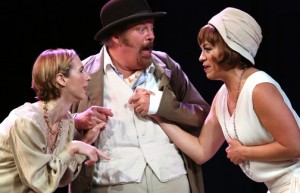
The ‘Merry Wives’ (Julia Coffey and Greta Wohlrabe) fool Falstaff (Richard Ziman) into yet another trick in Santa Cruz Shakespeare’s The Merry Wives of Windsor.
Photo by Shmuel Thaler.
The plot is an exceedingly thin and repetitive regurgitation of the famous commedia dell’arte get-in-the-bag lazzi in which an obnoxious man is tricked into hiding is a container “for his own protection” and then beaten by his alleged protectors. In MWW, Falstaff attempts to seduce two different (married) women by sending them identical proposals for assignations on the same day – apparently unaware that they are best friends. The women (repeatedly) pretend to accept and then in slapstick incidents punish the very-slow-to-get-the-picture Falstaff for his unwanted advances, while one also gets in some licks against a suspicious husband. The other gets her own comeuppance from a daughter who ends the play by becoming a wife to the man of her own choosing against the plotting of her mother for a very bad candidate.
In most modern productions the play is not very funny, because there are only so many ways a fat joke can be told and Falstaff is much less engaging in this play than he is in the histories. Brandt has launched the gender politics into the foreground, refocusing the play on the titular wives instead of Falstaff. Her leading actresses, Julia Coffey (Mistress Ford) and Greta Wohlrabe (Mistress Page), find the genuine humor in women who are tired of being underestimated and can run circles around the men in their lives.
Carly Cioffi (as Mistress Quickly) and Maribel Martinez (as the enterprising daughter, Anne Page) round out the cast of clever women. The director and her cast found astonishing depths in characters that are generally played much more superficially.
And Also There Were Men
The male cast was more than capably played – but given the conception of the evening – necessarily seemed more one-dimensional and less engaging. Ziman’s Falstaff was not the centerpiece of the evening, but he gamely took all his slapstick licks and summoned up his dignity at the end. The strongest performance was probably that of Mark Anderson Phillips whose jealous, “mansplaining” Master Ford was delightful.

Falstaff (Richard Ziman) is fooled yet again by “Master Brook”- Master Ford (Mark Anderson Phillips) in disguise in Santa Cruz Shakespeare’s The Merry Wives of Windsor.
Photo by Jana Marcus.
Kit Wilder (the Welsh parson Hugh Evans) and William Elsman (the French Doctor Caius) led the supporting actor contingent with loving charm.
The 1920s setting gives the set designer Eric Barker, the costume designer B. Modern, and the lighting designer Kent Dorsey a specific and recognizable period in which to work – and they all find magic in it.
B. Modern’s costumes, especially, reflect the perfect expression of women who are finding their freedom in times when men don’t yet “get it.” The best sight gag of the night is, however, Falstaff’s “disguise” as a garish and hugely rotund female fortuneteller.
Into the Woods
As You Like It was, by contrast, a much more staid and traditional production but situated in probably the most beautiful setting in the world for this play – The Sinsheimer-Stanley Festival Glen, a redwood paradise – it too was delightful. Scenic designer Michael Ganio and lighting designer Kent Dorsey made the most of this natural environment featuring it with spectacular combinations of light and shadow that drew audible gasps from the audience when curtains were drawn that revealed the vista.

Duke Senior’s forest court (SCS acting interns), Duke Senior (Richard Ziman) poke fun at the “melancholy” Jaques (Allen Gilmore) in Santa Cruz Shakespeare’s As You Like It.
Photo by rr jones.
Using a repertory cast for the summer, AYLI utilized the same personnel as Merry Wives, but often to vastly different effect. Julia Coffey, who proved such an excellent farceur as Mistress Ford, here expertly plays the much more emotionally complex leading woman, Rosalind. The contrast could not be higher, not least because she spends most of this play in convincing disguise as a young man. She is in the woods because she has been banished by her usurping uncle, Duke Frederick. She flees to the forest with her cousin Celia, disguising herself as protection against outlaws. If there are any such ruffians, however, we never see them. The forest is occupied by her father (the overthrown Duke) and his orderly, nostalgic courtiers. A recent arrival is a young nobleman, Orlando, who is also fleeing an inhospitable home, in his case running from a treacherous older brother.
Rosalind and Orlando have met before, when he unexpectedly won a wresting match with her in the audience, at which they fell for each other immediately. In this production Dan Flapper places the emphasis on Orlando as both extremely inarticulate and overly romantic. When the couple again meets in the woods, Rosalind has already assumed her male alter ego, Ganymede, which allows her to covertly tackle the problem that his worshipful and idealized courtship (he is posting bad love poems on trees) is less engaged than what she has in mind.
She undertakes to disabuse him of his poetic attitudes through “love lessons,” her male self impersonating her actual self in a series of scenes of dizzying complexity.

Rosalind playing her alter ego Ganymede (Julia Coffey) schools the love sick Orlando (Dan Flapper) in the ways of wooing in Santa Cruz Shakespeare’s As You Like It. Photo by Jana Marcus.
Flapper and Coffey have outstanding chemistry as the central couple. The courtship is less engaging that it is in some productions because Flapper’s Orlando never loses sight of the fact that these “love lessons” are just pretense and his real love is, he believes, elsewhere. (I read the play to suggest that Orlando finds himself developing very real feelings for Ganymede, which he neither understands nor controls.) In Mark Rucker’s production, however, it is Rosalind who loses sight of the game, kissing Orlando in an inappropriate moment from which he recoils. Still, the sparks are no less intense for this reversal.
Greta Wohlrabe plays Rosalind’s cousin Celia, and it is fascinating to see her paired with Mark Anderson Phillips playing Orlando’s repenting older brother Oliver. (In Merry Wives, they played Mistress Page and Master Ford, respectively.) Here, their chemistry rivals that of the main couple and their giddy humor becomes infectious.
Co-artistic director Mike Ryan plays the court jester, Toucstone, settling into country life with clarity and precision. It is a very difficult role, composed mostly of indecipherable old jokes, but he makes us understand.
In some ways this production was uneven. Richard Zinman doubles as both the usurped and usurping Dukes, but with no visual distinction and so little physical or vocal changes that he seems more like one character in two moods that contrasting brothers. With no other doubling of note in the cast, this proved a confusing convention. Allen Gilmore plays Jacques, the forest philosopher, as genuinely depressed and even his “seven ages of man” speech fails to land. William Elsman, a terrific and dependable actor, got some good laughs as the endlessly rejected country bumpkin, Silvius, but seems strangely miscast. (He seems perpetually used for egomaniacal roles in this company, like Doctor Caius in Merry Wives, but is actually a remarkably handsome and articulate actor who would have made a fine Orlando.)
By far the most original touch in the production was that Orlando’s faithful old retainer, Adam, (played by Marcus Cato) was given a prominent – and interpolated – death scene just before intermission. It was a darkness that would not return, however. Understandably, this summer the focus is on the miracle of the phoenix, and not on what is lost.
As You Like It, directed by Mark Rucker
Merry Wives of Windsor, directed by Kirstin Brandt
Santa Cruz Shakespeare
Reviewed on July 20, 2014, Running through August 10
Tickets: $16-48
Info: santacruzshakespeare.com
Don’t Trust Your Mentors – A Review of ROMEO AND JULIET at the Marin Shakespeare Company
July 31, 2014 § Leave a Comment
Romeo and Juliet is generally interpreted as a tragedy of youthful impetuousness, but thanks to two exceptionally powerful performances from supporting players Marin Shakespeare Company’s current production is, instead, an unconventional reading of the play as a tale of adult betrayal.
Youthful Leads
On its surface, Lesley Schisgall Currier’s production is generally traditional, although with a few interesting moments of intentional anachronism thrown in. Jake Murphy (Romeo) is genuinely youthful, on a summer break from pursuing his undergraduate degree, and onstage he seems believably adolescent. Romeo is a notoriously difficult character to play successfully as most young actors have trouble catching both the lover and the fighter in him. Murphy is more believable as the latter, but the depth of his passion grows near the end of the play and his suicide, which he played with both fear and gravity, was harrowing.
Luisa Frasconi is cast against type as Juliet. Her forte is comedy. She is wonderful as Phebe in As You Like It, the other play in rep at Marin, and was winning in The Liar at Livermore Shakespeare Festival last summer. She does not overly indulge her comic impulses in this production, but her broad physicality and her “Betty Boop” voice occasionally work against our taking her seriously. Although interesting enough in most ways, if the production had depended on them alone for its impact, these leads would lack the tragic stature needed to carry the evening.
More than Just Support
But in intriguing ways, Currier’s production is not focused on them. The early moments of the play are built on the power of the always-dependable Scott Coopwood as the Chorus that delivers the opening sonnet, and then as the Prince of Verona. Teddy Spencer as Tybalt and Jackson Currier as Mercutio both find very sinister readings of their characters and propel the middle of the play forward.
The production really comes into its own with the appearance of Julian Lopez-Morillas as the young couple’s spiritual guide and confidant, Friar Lawrence. (Last summer Lopez-Morillas, as the leading character Hieronimo, brilliantly carried this company’s production of the rarely-produced Spanish Tragedy.) This Friar Lawrence was strongly conveyed because Lopez-Morillas speaks Shakespeare’s verse exceptionally well, but the character was also interpreted as bright, insightful, and genuinely concerned for the welfare of the young couple. There was no doubt that his intentions were pure – that is, until the last moment. When he might have saved Juliet’s life, he callously abandoned her in a desperate bid for his own safety. The betrayal was shocking.
The most brilliant turn of the evening was delivered by Debi Durst, the queen of San Francisco’s improv comedy scene, as the nurse. She delivered everything that her reputation would suggest: hilarious as a chatterbox that cannot be quieted in her first scene, the bawdy equal of the young men who later accost her in the street, and fussily silly when withholding information from Juliet about Romeo’s intentions to marry her and her coming wedding night.
She is so charming and funny that, even if you know the play well, you are unprepared for her reaction in the moment when Juliet seeks an ally against her tyrannical father (played by the company’s artistic director, Robert Currier.) In this central moment, Durst smoothly slides into the recommendation that Juliet quietly pretend her marriage to Romeo never existed and bigamously marry the wealthier Count Paris without so much as a backward glance. I’ve seen this moment played as consciously venal, and as completely opportunistic before, but Durst’s rendition clearly revealed the desperation with which she held onto her small position in a grand household as her only defense against a life of exponential loss. It was much more than the ability of a comedian to reveal the pain underneath the laughter: it seemed stunningly contemporary: in a bad economy down-and-out elders will sell out their protégés in an instant if it buys them even a little while longer on the trickle-down fringe.
Mostly Cloudy with Scattered Silliness
The combined impact of Lopez-Morillas and Durst was such that the play seemed to mean something insightfully different than the message it usually delivers. Instead of a warning about the rashness of youth, this performance seemed much more concerned with the danger of their gullibility about the “benevolence” of their elders. At least in this production, times are tough and an entire generation is abandoned to its own devices. Currier seems to suggest that far from a tragedy of fate, the loss of these two innocent teenagers was entirely preventable by trusted mentors who failed to step up to the plate.
This dark vision generally permeated the play, although Adam Roy (as the clown character, Peter) pushed hard in the opposite direction. On opening night he was clearly an audience favorite, as he had been as Touchstone in As You Like It. It is a performance I liked much less than those around me – worrying that he was frequently stealing focus and diluting the cynicism with which this production is infused – but it is only fair to say that I seemed pretty much alone in this assessment.
This is a company that places its emphasis on acting instead of spectacle. Jackson Currier is credited with the inoffensive set design, although only in the set decoration was it any different from the one used in As You Like It, credited to Joel Eis. Abra Berman’s black-and-white costumes were more aesthetically suggestive, achieving their impact in contrast to Romeo and Juliet’s blood red final apparel. Maxx Kurzunski’s lighting was little more than general illumination, and seemed to bear a curiously inverse relationship to the logical amount of light the scenes needed. (The gloomy crypt was the most brightly lit scene of the evening. Go figure.)
As You Like It
Marin Shakespeare Company
Directed by Lesley Schisgall Currier
Attended July 26, 2014, playing through Sept. 28
Tickets: $12-35 or “pay your age”
Info: marinshakespeare.org
